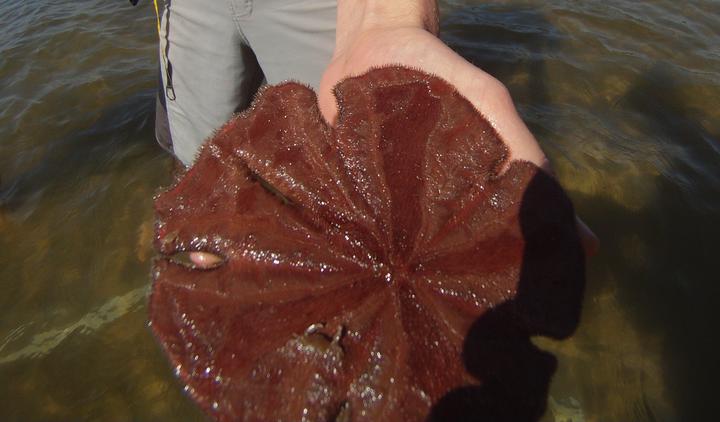Distribution patterns of ectosymbiont crabs and their sand dollar hosts in a subtropical estuarine sandflat
 Image credit: Marco C Brustolin
Image credit: Marco C BrustolinAbstract
Encope emarginata (Leske, 1778) are frequently observed aggregated in the sediment and variations in its spatial patterns of distribution may be a function of changes on local hydrodynamic regime. Tiny crabs, Dissodactylus crinitichelis Moreira, 1901 living associate with these irregular echinoids. It is unclear whether the presence of crabs can affect the fitness of hosts and if this effect may be dependent on the abundance of crabs that a sand dollar is capable of hosting. If we consider that sand dollars act as substrate for symbionts then, they are subject to intraspecific competition for space. Based on this assumption, we hypothesize that the abundance of crabs will be positively correlated with sand dollar size. Two sampling campaigns were made, one in September - 2011 and other in May - 2012. Sand dollars were counted and measured in situ at the tidal flat in front of Cobras’ Island (25° 29’ 5” S - 48° 25’ 48” W) in the Paranaguá Bay - Southern, Brazil. Four parallel transects were distributed between depths of 0.5 to 2 m and the number of individuals were counted in a sample area of 4 m². In another moment, 164 sand dollars and their symbionts were measured. We observed 906 specimens of E. emarginata (558 in Sep / 11 and 348 in May / 12). Sand dollar densities range from zero to 20 ind. 4 m-², and had an aggregate distribution pattern with patches of different densities within transects and periods (F2, 15 = 9.466, p < 0.01). Patches were observed near to the coast in Sep / 11 compared with May / 12. The symbionts D. crinitichelis present a more variable distribution pattern if compared with sand dollars. In Sep / 11, crabs were clumped distributed as well as sand dollars. On the other hand, in May / 12 D. crinitichelis was random distributed, displaying a distinct pattern than those observed for E. emarginata hosts. No relationship between size of E. emarginata and the number symbionts was observed (Longitudinal axes: r = - 0.021, p < 0.05; Transverse axes: r = - 0.017, p > 0.05), refuting the hypothesis that space is a limiting resource for the crabs. On the contrary, distribution patterns of D. crinitichelis were seemingly influenced by the distribution of their host population, rather than by one single host specimen. This suggests that other factors (e.g., the spatial distribution and connectivity between patches within a population of sand dollars) may be more important for the population dynamics of D. crinitichelis than competition for space per se.
Supplementary notes can be added here, including code, math, and images.